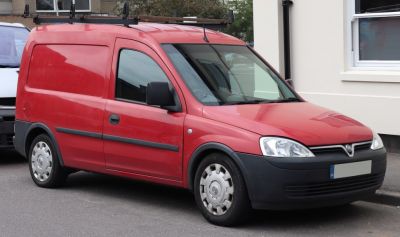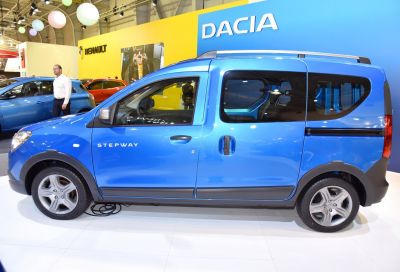 2003 Opel Combo Tour C (facelift 2003) Dimensions, Size & Specs
2003 Opel Combo Tour C (facelift 2003) Dimensions, Size & SpecsMeasurements of the 2003 Opel Combo Tour C, engineered for optimal performance and comfort
| Dimensions | |
|---|---|
| Length: | 4322-4332 mm170.2-170.6 in14.2-14.2 ft |
| Width: | 1684 mm66.3 in5.5 ft |
| Width (Opened Mirrors): | 1892 mm74.5 in6.2 ft |
| Height: | 1801 mm70.9 in5.9 ft |
| Ground Clearance: | 160 mm6.3 in0.5 ft |
| Trunk Capacity: | 455-510 liter16.1-18.0 cu ft |
| Trunk Capacity (Max): | 2700-3200 liter95.3-113.0 cu ft |
| Weight Specifications | |
| Curb Weight: | 1205-1367 kg2657-3014 lbs |
| Maximal permitted Weight: | 1725-1945 kg3803-4288 lbs |
| Roof Load: | 100 kg220 lbs |
| Tire Specifications | |
| Rims Sizes: | 15-inch rims:
|
| Tire Sizes: |
|
The Opel Combo Tour C (facelift 2003) is a versatile minivan produced from 2003 to 2010. It features a compact yet spacious design, perfectly suited for families and businesses needing practical transport with ample room. The vehicle's length ranges between 4322 mm and 4332 mm (approximately 170.2 to 170.5 inches), while it maintains a width of 1684 mm (66.3 inches) with closed mirrors. When mirrors are opened, width extends to 1892 mm (74.4 inches), aiding maneuverability consideration in tight spaces. Standing at a height of 1801 mm (70.9 inches), the Combo Tour C ensures comfortable headroom inside the cabin. Weighing between 1205 kg and 1367 kg (2657 to 3014 lbs) depending on configuration, it supports a maximum weight capacity ranging from 1725 kg to 1945 kg (3805 to 4289 lbs).
One of the key features of the Combo Tour C is its impressive luggage capacity. With all seats in place, it offers a cargo volume from 455 liters up to 510 liters (16.1 to 18 cubic feet), which expands dramatically to between 2700 liters and 3200 liters (95.3 to 113 cubic feet) when the rear seats are folded down. This versatility makes it ideal for transporting bulky items or extensive luggage. The vehicle sits 160 mm (6.3 inches) above the ground, providing a balanced ride height that accommodates urban and suburban driving conditions while allowing moderate off-road capability.
The Combo Tour C is equipped with rim sizes of 6J x 15 and 6J x 16, paired with tire dimensions of 185/60 R15, 175/65 R14, and 195/50 R16. These tire options deliver a good balance of grip, comfort, and handling, enhancing the overall driving experience. The roof load capacity of 100 kg (220 lbs) further extends its practicality, enabling additional cargo or roof rack options.
Overall, the Opel Combo Tour C (facelift 2003) offers a well-rounded package, combining practical dimensions, significant cargo space, and adaptable design, making it a competitive choice in the minivan segment during its production years.
Discover the standout features that make the 2003 Opel Combo Tour C a leader in its class
Have a question? Please check our knowledgebase first.
The Opel Combo Tour C facelift model from 2003 measures between 4322 and 4332 mm (approximately 170.2 to 170.6 inches) in length, 1684 mm (66.3 inches) in width without mirrors, and 1801 mm (70.9 inches) in height. When accounting for opened side mirrors, the width extends to 1892 mm (74.4 inches). These dimensions reflect a compact but spacious minivan design aimed at balancing maneuverability with interior space. This size makes the vehicle well-suited for urban environments while still providing ample interior room.
The curb weight of the Opel Combo Tour C (facelift 2003) ranges between 1205 kg and 1367 kg (2657 to 3013 lbs), depending on configurations and equipment levels. The maximum allowable weight (gross vehicle weight rating) spans from 1725 kg to 1945 kg (3805 to 4289 lbs), indicating the highest total vehicle mass including passengers, cargo, and fuel. The variation in weight capacities is influenced by trim levels, engine choices, and optional equipment, but these figures ensure the vehicle can handle substantial load without compromising safety or performance.
The Opel Combo Tour C facelift offers versatile cargo space tailored to family and utility needs. With rear seats in place, the luggage capacity ranges from 455 to 510 liters (16.1 to 18 cubic feet), providing sufficient room for groceries, luggage, or sports equipment. When the rear seats are folded down, cargo space expands dramatically to between 2700 and 3200 liters (95.3 to 113 cubic feet). This flexible space allows the Combo Tour C to accommodate large items or bulky gear, making it highly practical for diverse usage scenarios.
Yes, the Opel Combo Tour C facelift is generally compatible with standard residential garages. Typical single-car garage dimensions tend to be at least 2.5 to 3 meters wide (98 to 118 inches) and 5 to 6 meters long (196 to 236 inches), which comfortably accommodate the Combo's length of approximately 4.3 meters (170 inches) and a width (with mirrors folded) of 1.68 meters (66.3 inches). However, with side mirrors opened, the width extends to 1.89 meters (74.4 inches), so extra care is advisable when parking in tighter spaces with mirrors deployed. Its height of 1.8 meters (70.9 inches) poses no clearance issues in standard garages.
The Opel Combo Tour C facelift stands at a height of 1801 mm (70.9 inches), offering a relatively high roofline typical for a minivan, facilitating easy entry and exit plus good interior headroom. Its ground clearance measures approximately 160 mm (6.3 inches), which balances urban driving with the ability to handle modest rough surfaces or light off-road conditions without trouble. While not designed as an off-road vehicle, this clearance helps prevent underbody damage on speed bumps and uneven road surfaces, making it versatile for everyday use.
The standard Opel Combo Tour C facelift offers several rim and tire size options to balance handling, comfort, and appearance. Rim sizes include 6J x 14 inches, 6J x 15 inches, and 6J x 16 inches. Corresponding tire sizes include 175/65 R14, 185/60 R15, and 195/50 R16. This variety allows owners to select setups suited to their driving style and load requirements, with larger rims generally offering improved stability and aesthetics, while smaller rims may enhance ride comfort and cost-effectiveness.
Compared to its predecessor, the pre-facelift Combo C, the 2003 facelift version maintained very similar overall dimensions, with subtle refinements improving utility and appearance. The length remained around 4.3 meters (about 170 inches), while width and height were largely unchanged, preserving its compact minivan footprint. The facelift focused more on styling updates and interior enhancements rather than drastic dimensional changes. However, the slight tweaks improved aerodynamics and interior space usage, making the facelift model feel more modern and practical without increasing the vehicle's footprint.
Within its segment, the Opel Combo Tour C facelift is competitively sized, balancing between small cargo vans and larger family minivans. Compared to similar vehicles like the Citroën Berlingo or Peugeot Partner, it offers comparable length (~4.3 meters or 170 inches), width, and height figures. Its cargo capacity, especially with rear seats folded (up to 3200 liters or 113 cubic feet), is generous, rivalling or exceeding many competitors. This makes it versatile for both family use and commercial applications, providing a strong mix of compact dimensions with substantial internal space.
The recommended roof load capacity for the Opel Combo Tour C facelift is 100 kg (about 220 lbs). This rating is important because it defines the maximum weight that can safely be placed on the vehicle's roof, including roof boxes, racks, or other cargo. Adhering to this limit ensures vehicle stability and safety by preventing excessive strain on the roof structure and preserving proper handling characteristics. Overloading the roof can adversely affect driving dynamics and cause long-term damage, so respecting this capacity is critical for safe vehicle operation.
The Opel Combo Tour C facelift, produced from 2003 to 2010, is a practical minivan designed for versatile daily use. It is prized for its flexible interior space, accommodating both passengers and significant cargo volumes, especially with rear seats folded. The facelift introduced updated styling cues along with refined interior materials and improved ergonomics. It is commonly used by families, small businesses, and tradespeople for its reliable performance, efficient fuel economy, and easy maneuverability in urban environments. Its sturdy build combined with practical dimensions made it a popular choice in the compact MPV segment during its production run.
Discover similar sized cars.

| Production: | 2001-2011 |
|---|---|
| Model Year: | 2001 |
| Length: | 4320-4332 mm170.1-170.6 in |
| Width: | 1685 mm66.3 in |
| Height: | 1801 mm70.9 in |

| Production: | 2017-2020 |
|---|---|
| Model Year: | 2017 |
| Length: | 4388 mm172.8 in |
| Width: | 2004 mm78.9 in |
| Height: | 1852 mm72.9 in |
